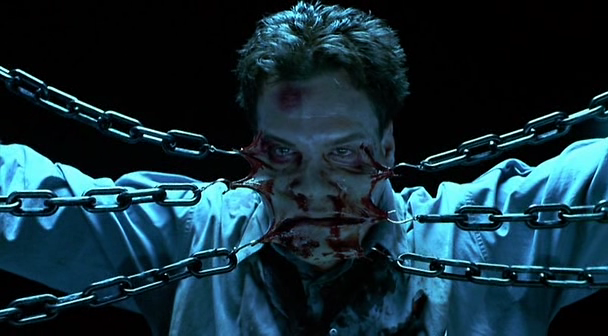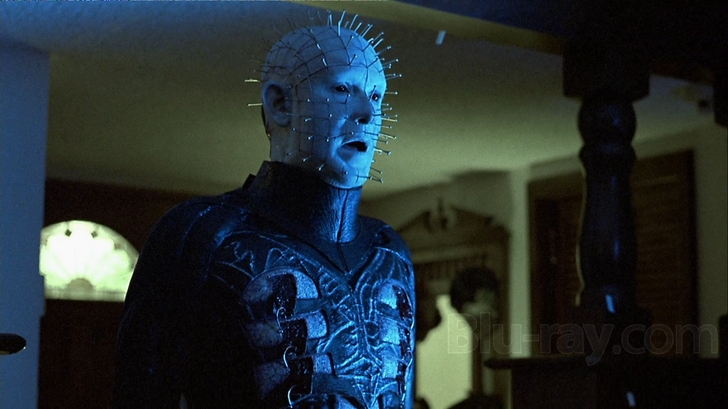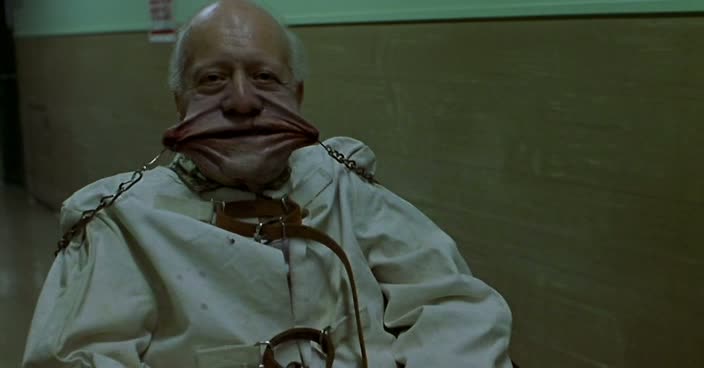
Hollywood loves a good franchise. The movie-going public does too. Horror, action, comedy, sci-fi, western, no genre is safe. And any film, no matter how seemingly stand-alone, conclusive, or inappropriate to sequel, could generate an expansive franchise. They are legion. We are surrounded. But a champion has risen from the rabble to defend us. Me. I have donned my sweats and taken up cinema’s gauntlet. Don’t try this at home. I am a professional.
Let’s be buddies on the Facebookz!
The Franchise: Hellraiser — concerning a supernatural puzzle box (and those humans foolish/unlucky enough to solve it) that opens a doorway to the hellish dimension of Pinhead, the most prominent member of the Cenobites, powerful beings who desire human souls for sadomasochistic experiments. Adapted from Clive Barker’s novella The Hellbound Heart, the franchise spans nine films, from 1987 to 2011.
previous installments
Hellraiser
Hellbound: Hellraiser II
Hellraiser III: Hell on Earth
Hellraiser IV: Bloodline
The Installment: Hellraiser: Inferno (2000)

The Story:
Joseph Thorne (Craig Sheffer) is a super smart nerd and a sexy jock. We know this because he plays speed chess while talking on the phone moments after playing a game of basketball at the gym. Paying attention, ladies? Cause he’s a bad boy too. We know this because he snorts some cocaine in the gym’s locker room. He also carries a gun and – oh snap! He has a badge! He’s a shady cop! OMG, he even does magic tricks too! If ever there was a guy to get Cenobitten, it is Joe. And we don’t have to wait long. It is Joe’s line of work that brings him into the world of Hellraiser, when he and his partner, Det. Tony Nenonen (Nicholas Turturro), arrive at a crime scene where someone very clearly had their soul torn apart by certain explorers of the outer reaches of experience. Because Joe is a stand up guy, he steals some drugs from the crime scene… and the Lament Configuration, which the recently deceased was illogically using as a candleholder (how did the guy open the box if a candle was stuck to the top?). Now Joe does what anyone would — he gets a hooker! After a solid hooker bangin’ Joe decides to futz around with the puzzle box. He isn’t whisked away, but when Joe wakes up the following morning his life begins to unravel. The hooker is murdered, which Joe decides to cover up (naturally). And more bodies begin to pile up, all with ties to Joe. As Joe follows the clues, all signs seem to point to the puzzle box and a mysterious person known only as The Engineer. Will Joe be able to save his soul? The pic below says no!

What Works:
All the Hellraiser sequels following Bloodline have one great thing working in their favor: expectations could not be lower. Regardless of how much they loved the first two films, most horror fans seem to have become aggressively disenchanted with the series after either the third or fourth entry. Thus formed a deep chasm after Bloodline, with only the bravest or most zealous venturing beyond into the darkness. It was as a wary traveler that I approached Hellraiser: Inferno, the first Hellraiser film to go straight to video, the first to completely detach from the existing story arcs and characters, the first in which Doug Bradley seemed interested in only doing a couple days of filming, despite the increasing popularity of his character. Three hallmarks of a franchise that has overstayed its welcome, if I’ve ever seen ’em. Yet, rather surprisingly, Inferno is not a bad film. Actually, for the first half it is quite good — better than Hell on Earth or Bloodline, I’d say.
I have some serious issues with where Inferno ultimately goes, but screenwriters Paul Harris Boardman and Scott Derrickson (also director) deserve some credit for having their heads in the right place. Conceptually, this is exactly what the franchise should be doing. As we’ve already talked about, Hellraiser is a tricky formula to work with. Realistically, it was necessary for the filmmakers to run with the Pinhead ball so we could all learn that a little of him goes a long way; the unfortunate part is that it kinda killed the franchise for people. Doubly unfortunate because now we’ve reached the point where the franchise should be able to relax and tell some proper Hellraiser stories. Pinhead should be used similarly to how Neil Gaiman used Sandman in the later arcs of the Sandman comic series (ie, sparingly, for those who haven’t read Sandman). Gaiman liked to joke that Sandman had become too big and expensive of a star, so he had to limit how much of the stories Sandman was actually in. Here, with Doug Bradley, that takes on some legit reality I’m sure. But I love that we’ve now dropped the previous throughlines. Inferno feels like an episode of a Hellraiser anthology show. Which I think is a good thing. The Cenobites should be kept at a distance. Also, the components that Clive Barker gave us work best when our main character is a bad person. Even though Inferno feels small and disjointed coming on the heels of the first four films, it also feels like a breath of fresh air, largely because Joseph Thorne is the most worthy protagonist we’ve had since Frank and Julia.
Craig Sheffer has always been a non-entity in my mind. He’s basically David Boreanaz, minus the dreamboat factor that Boreanaz seems to have. But I gotta say, he impressed me in Inferno. Joe is the whole movie, and Sheffer rather confidently carries the film, making a very convincing noble shitbag, both physically and performance-wise. In the best film noir fashion, he’s the kind of guy I enjoy watching circle the drain and fall apart over the course of a film. The problem with centering a Hellraiser film on a good person, even one surrounded by bad people, is it makes the film feel clean. The original Hellraiser felt dirty. Hellbound was dirty too. Inferno also feels dirty. That said, I liked that Joe was legitimately trying to solve the central mystery of the episode — he was a dirty bad man, but also just good enough to make the story work. If he’d be all bad, constantly murdering people to cover up his own crimes, then we would become disinterested in his quest to clear his name. That’s the sort of situation that gets us saddled with a Kirsty character, muddling the perspective of the narrative. In this sense, Joe is actually the best protagonist the franchise has had yet.
There are several bits in the film that worked well for me. Having our hero be a cop who stumbles upon a Cenobite crime scene is a great way to kicks things off — similar to Hell on Earth, with a reporter stumbling upon a Cenobite scene, only more plausible (seemed odd that the Cenobites allowed their victim in Hell on Earth to get all the way to the emergency room before he was torn apart by those chains; rather convenient for the story). Similarly, I enjoyed Joe’s hard-boiled journey into the Cenobite mystery, turning up clues, visiting questionable tattoo shops, and abusing stool-pigeons. Inferno is probably what we would’ve gotten if Mickey Spillane had written a Hellraiser story. The film also has some respectable bits of imagery, like the candle Joe finds with a child’s finger inside it. And though the film had completely lost me by the very end, the Groundhog’s Day denouement salvaged things a little bit (more on this in the next section).
In its own way the film also adds nicely to the overall world of Hellraiser. What has always been intriguing about the Cenobite/puzzle box mythos is that it isn’t a secret. There are plenty of people who know or at least mostly grasp the basic tenets, and our stories are simply revolving around people who don’t know, who either foolishly or tragically stumble into this world. This fits very naturally into our noirish cop tale, if we just replace a criminal syndicate with a Cenobite cult (actually, plenty of classic hard-boiled detective stories involved cults, so it’s not much of a stretch at all). Inferno is sort of like a sincere version of Cast a Deadly Spell, full of classic detective genre archetypes, infused with a supernatural twist. Things go off the rails once we encounter the nonsensical cowboy characters (led by Breaking Bad‘s Michael Shamus Wiles), but it is fun while it lasts. Though, there is a part of me that wants to commend the film for having identical twin ninja cowboys… and not offering up any kind of context for their existence.

What Doesn’t Work:
The closer we move to the end of the film the more Inferno starts to lose its charm, as it becomes more of a Jacob’s Ladder knock off than a Hellraiser film, full of kooky hallucinations and spazzy demons. I was forgiving a lot – such as the blah new Cenobites – but once we reached the twist that James Remar’s character, police psychiatrist Dr. Paul Gregory, has been Pinhead all along and that really nothing in the movie had ever happened, the ever more precarious story lost its balance for me.
For one thing, I think making The Engineer (who you’ll recall was the actual leader of the Cenobites in Barker’s novella) simply Pinhead in disguise is an uninspired move and missed opportunity for something more interesting. While I appreciate that Inferno dropped the angle that Pinhead is trying to conquer our world, it was still disappointing to discover that the entire movie had been a fantastical rite of passage for Joe to connect with himself as a child or whatever (at each new crime scene a child’s finger had been found, but it turns out that the fingers are from Joe himself! As a child! Mind blower!!!). I suspected the moment Joe passed out after opening the puzzle box that we were going to be dealing with a displaced reality, but I was nonetheless excited by the idea that maybe we were going to be introduced to a new wrinkle in the Cenobite world — an operator who was human himself. The first film gave us the Asian merchant, who was then completely worked out of the Hellraiser mythos, despite seeming like a pivotal component. A mysterious “Engineer” at the center of a network revolving around the Lament Configuration seems like a great opportunity to return to such a character. What we’re left with are two possibilities, neither of which I like: 1) there is no Engineer, because everything that happens in the film is 100% in Joe’s personal hell, or 2) despite everything we’ve seen in the franchise up until this point, Pinhead can access our world in disguise, a disguise that looks like veteran character actor James Remar. I super hate #2, so I choose to believe the film meant #1.
In Inferno, when Joe asks James Remar’s character what he knows about the puzzle box and the Cenobites, he says: “It opens. They come for you. They leave.” Of course, the very film we’re watching dispels this notion. They didn’t take Joe. They’re fucking around with him. The Groundhog’s Day ending, in which Joe discovers that every time he dies he will be birthed again at the moment after he opened the puzzle box, saved the film somewhat by at least implying that Pinhead wasn’t fucking with Joe in the real world, but rather that this (ie, the movie) was Joe’s private hell; something that indeed fits in with the franchise’s mythos. I’m down with that. But it didn’t make the film I’d just sat through any better — it just meant that I wasn’t going to bitch about its break with franchise continuity. About midway through the film it became clear to me that Joe was just going to keep getting more and more displaced from reality, which was inevitably going to pull us out of the hard-boiled detective motif and into wannabe Lynchian nightmare nonsense; which it did, literally climaxing in a moment where Joe rips off the face of his adversary only to discover that – wait for it – it is his face hidden beneath! Mind blown again!!!
And can we please get some continuity on what it takes to open the fucking puzzle box? Joe barely touches it and it activates. Until it became obvious that we were in a weird nightmare reality, I wondered if the reason Joe hadn’t been whisked away to Cenobiteberg was because he’d encountered a random glitch with the Lament Configuration or something. Along these continuity lines, at this point there isn’t much consistency with what happens when the Cenobites come for you. In Hellraiser there is no trace of Frank left in the attic after he gets torn apart. In Inferno the remnants of the film’s first victim are left behind on the floor for Joe and everyone to find. Though, to be fair, this can’t be held against Inferno, as the previous sequels had been all over the map too.
It seems counter-productive to say it, but we don’t get quite enough Pinhead here. Or at least the minimal Pinhead we get isn’t very good quality. His dialogue is a sad shadow of its former glory, and his motives are completely shifted from that of a pleasure/pain explorer and re-purposed to that of a righteous judge and punisher. I won’t take Inferno to task over his presentation, because as I said earlier, objectively this is a move in the right direction. It’s a noble failure, in regards to Pinhead.
I love James Remar, but the long distance charges for his phoned-in performance here must have been huge.
The music is also really terrible. I am guilty of failing to praise the scores in Hellraiser and Hellbound. Let my complaint about the synth crud we’re given here be retroactive applause.

Overall Body Count: 8.
Best Kill: When Joe finds his daughter strapped to a Cenobite pillar and touches her arm, only for it freeze over and break off grossly. I’m a sucker for frozen people breaking apart.
Best Cenobite That Isn’t Pinhead: I kinda liked the Johnny Eck Cenobite.
Best Badass Pinhead Line: Not applicable.
Best Whimsical Pinhead Line: Not applicable.
Stupidest Pinhead Line: “It’s all a puzzle, isn’t it, Joseph? Like a game of chess, perhaps. The pieces move, apparently aimlessly, but always towards one single objective: to kill the king. But who is the king in this game, Joseph? That is the question you must ask yourself.”
Most Unpleasant Moment: When two of our new Cenobite characters, who I will call the Cenobites Skanks, “sexily” stick their hands under the flesh of Joe’s chest. Some good body horror.
Should There Have Been a Sequel: I like where the franchise’s head is at. A possible new beginning. So why not? Let’s see where things go.

Up Next: Hellraiser: Hellseeker
previous franchises battled
Critters
Death Wish
Leprechaun
Phantasm
Planet of the Apes
Police Academy
Rambo
Tremors